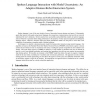22 search results - page 4 / 5 » Large vocabulary sign language recognition based on hierarch... |
TASLP
2010
13 years 2 months ago
2010
Traditional n-gram language models are widely used in state-of-the-art large vocabulary speech recognition systems. This simple model suffers from some limitations, such as overfi...
ICDAR
2007
IEEE
14 years 1 months ago
2007
IEEE
Using a lexicon can often improve character recognition under challenging conditions, such as poor image quality or unusual fonts. We propose a flexible probabilistic model for c...
NAACL
1994
13 years 9 months ago
1994
The key problem to be faced when building a HMM-based continuous speech recogniser is maintaining the balance between model complexity and available training data. For large vocab...
CVPR
2004
IEEE
14 years 9 months ago
2004
IEEE
Making decisions based on a linear combination L of features is of course very common in pattern recognition. For distinguishing between two hypotheses or classes, the test is of ...
CONNECTION
2008
13 years 7 months ago
2008
Spoken language is one of the most intuitive forms of interaction between humans and agents. Unfortunately, agents that interact with people using natural language often experienc...

